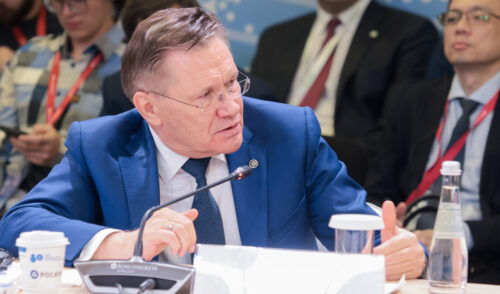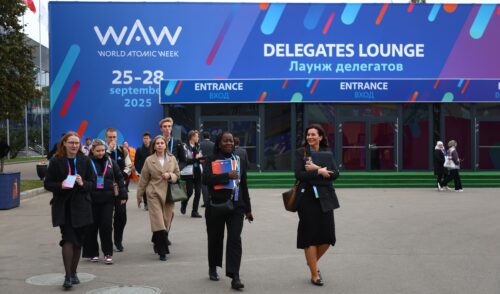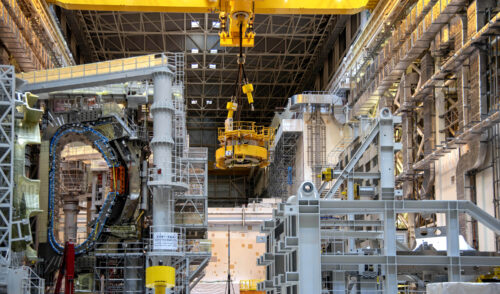
ITER Russia presented status report
back to contentsRussia is an active participant of the ITER project. In late 2015, Rosatom signed three more equipment supply agreements with the ITER Organization, with the last one pending signature later this year. Obligations of Russia as a project stakeholder comprise the production, delivery and installation of 25 ITER systems, including 10 process components and 15 analyzers. Work is going on across all the systems, and one of the tasks has been fully completed, explains Anatoly Krasilnikov, Head of ITER Russia. “This task is the production and delivery of toroidal field superconductors for the ITER magnet system, the first component we are responsible for.” The toroidal magnetic field will serve to confine and stabilize plasma in the thermonuclear reactor. Superconducting strands for ITER magnet coils were produced at the Chepetsk Mechanical Plant while the manufacturing technology was developed by the Russian Research Institute of Inorganic Materials (the both companies are subsidiaries of Rosatom’s TVEL Fuel Company). Each strand consists of nearly 10,000 superconducting fibers only 2 to 6 microns thick. A human hair is several times thicker. Strands produced at the Chepetsk Mechanical Plant were delivered to the Russian Cable Industry Research institute in Podolsk (Moscow Region) to make superconducting cables, which were subsequently jacketed (put into a steel jacket) at the Institute of High Energy Physics in Protvino (Moscow Region). Final tests were performed at Kurchatov R&D Institute. Finished cables were sent to European companies tasked with the production of toroidal field coils. “Close cooperation between our companies helped produce the best superconductors. It was a decision of the ITER Organization to make the most critical toroidal coils out of Russian superconductors. This is a clear recognition of our competencies by the international community, isn’t it?” Anatoly Krasilnikov says proudly.
It took a total of five years to produce, test and supply 28 ‘standard lengths’ (separate pieces) of a toroidal field superconductor. According to Krasilnikov, Rosatom has revived the Russian hi-tech superconducting industry whose products have a variety of applications, among them the production of domestic CT scanners.
Different mentality
“The ITER project completion is postponed for approximately five years. Now the first plasma is not expected to be obtained before 2025,” Anatoly Krasilnikov said in advance of reporters’ questions.
The ITER development project involves hundreds of companies and organizations from seven participating countries. “Differences in mentality and decision-making processes slow down the project pace,” Anatoly explains. According to him, Russia and China have always been performing their obligations in time and have fallen hostage to other project stakeholders who do not always meet the time schedule when doing their part of the job. The ITER project is remarkable for a close cooperation between the stakeholders, and any delay by one country hampers the entire project’ progress. To improve the situation, Bernard Bigot (who superseded Osama Motojima as ITER Organization Director-General in March 2015) made a decision to change the project schedule. In November 2015, the ITER Council approved a new schedule and milestones for 2016 and 2017 and reach agreement on the overall schedule through the first plasma by June 2016. The Council did not rule out the possibility of re-distributing the scope of work between the project stakeholders.
“The project will be continued as scheduled within the next two years,” says Vyacheslav Pershukov, Rosatom Deputy CEO for Innovation Management and a member of the ITER Council. “This is a positive decision – we can continue working in accordance with the plan so that our production capacity is fully utilized, and we need not look for other orders.”
According to a source in ITER Russia, the new director got the things moving – two ground floors of the main building were completed, with the construction of the first floor in the main experimental building started in January.
ITER not affected by sanctions
How do political tensions affect the international project? “Sanctions do not apply to the ITER project in most cases. Fusion research is a joint effort, and no stakeholder is interested in throwing sand in the machine when implementing such an extensive project,” Anatoly Krasilnikov assures. The project was launched in the mid-1980s by four partners – the Soviet Union, Europe, the USA and Japan. The design was developed jointly by all the four project stakeholders. China, India and South Korea joined the project at the construction phase. The ITER remains open for new participants. “There have been others willing to participate, among them Brazil, Turkey, Australia, Canada and Kazakhstan. New project members will be admitted if they make a financial contribution because responsibility areas of the project technology have been already divided between the existing participants,” Anatoly Krasilnikov explains.




